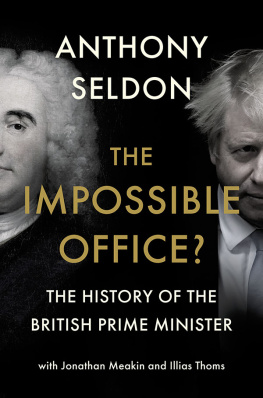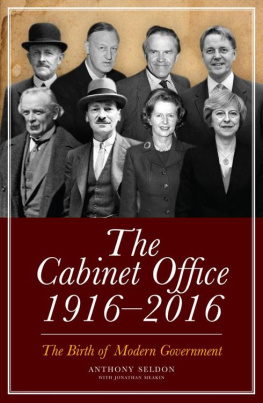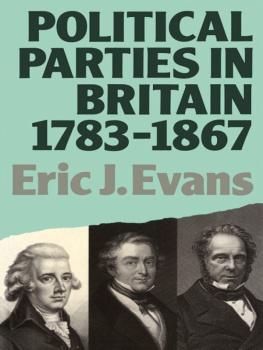Fourth Estate
An imprint of HarperCollinsPublishers
1 London Bridge Street
London SE1 9GF
www.harpercollins.co.uk
Fontana Press Original 1996
Copyright Anthony Seldon 1996
Anthony Seldon has asserted the moral right to be identified as the editor of this work
All rights reserved under International and Pan-American Copyright Conventions. By payment of the required fees, you have been granted the nonexclusive, nontransferable right to access and read the text of this e-book on-screen. No part of this text may be reproduced, transmitted, downloaded, decompiled, reverse-engineered, or stored in or introduced into any information storage and retrieval system, in any form or by any means, whether electronic or mechanical, now known or hereafter invented, without the express written permission of HarperCollins e-books.
HarperCollinsPublishers has made every reasonable effort to ensure that any picture content and written content in this ebook has been included or removed in accordance with the contractual and technological constraints in operation at the time of publication.
Source ISBN: 9780006863663
Ebook Edition JUNE 2016 ISBN: 9780008191634
Version: 2016-05-26
The editor wishes to thank all his contributors, who endured his coaxing, prodding and perhaps over-prescriptive brief with exemplary good humour.
My colleagues at the Institute of Contemporary British History and St Dunstans College have as always been a tower of support and stimulation. I am deeply grateful to the individuals who comprise both these outstanding organizations, and am very proud of my association with them.
Particular thanks to my collaborator on two books, Stuart Ball, for his intellectual input into this book, and also to my lifelong friend and mentor John Barnes, for his inspiration and genius on all matters concerned with the history of the right in Britain. The selfless guidance of both helped me not least in their comments on my introduction and conclusion.
Lewis Baston, my principal researcher on the biography of John Major, has been an enthusiastic presence throughout this book. I learnt much about the party and voting patterns from Russell Tillson. My editorial assistant and secretary Annemarie Weitzel has remarkably kept me and everyone else up to the mark. At HarperCollins the irrepressible duo of Philip Gwyn Jones and Toby Mundy proved again delightful and efficient partners while Caroline Hotblack put in sterling and sensitive work as picture researcher. Copy-editing was completed most effectively by Ian Gerrard, another Major researcher; Daniel Collings and Willian Gelling, both of Tonbridge School helped prepare the book for publication.
Finally, my thanks to my wife and young family for patience which would take two hundred years to repay.
ANTHONY SELDON
May 1996
This book examines over two hundred years of the Tories in power. The party dominated the late eighteenth century, the start and end of the nineteenth century, and much of the twentieth century, and has been the most consistently successful political party not just in Britain but in the democratic world.
The post-1660 Restoration court of Charles II saw the first emergence of a Tory faction, a group that became better defined after the Glorious Revolution of 1688 and the emergence of a Whig group to rival the Tories. By the last years of Queen Annes reign from 1710 to 1714 the Tories had emerged triumphant, but British politics for fifty years after the 1720s was dominated by the Whigs.
This book settles on 1783 as its starting date, not because any clear set of Tory policies had emerged, but because December of that year saw the younger William Pitt become prime minister, and the beginning of a period of coalescence of attitudes and beliefs, spurred by the French Revolution, which were to define what the party stood for in the nineteenth century.
Ten periods of Tory dominance are described in the book. Authors were asked to address themselves to the nature of the party during the period in power they were describing: what was the basis of the Tories initial election victory; what were the unifying themes of policy during the period; what was the partys prevailing ideology; what interests were the Tories representing most closely during the period; what was the quality and the location of leadership (that is, to what extent was it collective); to what extent did any formal or informal partnership with another party exist, and how did it affect the substance of government policy. Authors were then asked to address themselves to the reasons for downfall, and were invited to consider nine factors in demise, as outlined in the Conclusion.
The Tory Party 17831996
The Tory Party has changed enormously over the two-hundred-year period examined. Pitt, Prime Minister from 1783 to 1801 and 1804 to 1806, called himself an independent Whig. Almost no members of Parliament called themselves Tories until after the Great Reform Act of 1832, and MPs did not regard themselves as belonging to a cohesive and disciplined party, although the emergence of collective responsibility, not least under Lord Liverpool, enhanced the process. The 1832 Act accelerated the development of modern political parties, and established the principle that it would be success in general elections, rather than the will of the monarch, that would change parties in government. The Tories thus had a powerful spur to organize themselves as a party to win general elections.
The power of the Crown, notably George III and George IV, to create and end ministries, and the looseness of the description Tory, are the defining characteristics of the first two chapters, by Jeremy Black and Norman Gash, covering the periods 17831806 and 181230. Defence of the position of the established Anglican Church, respect for the role of the monarchy and a strong stance in support of property, order and the landed interest the legacy of the French Revolution were the prevailing principles of the ministries in these periods. Liverpools ministry from 1812 to 1827 saw a renewed emphasis on law and authority, a contempt for radicalism and populism, and a distrust of the Foxite Whigs. Support for the war against Napoleon from 1810 to 1815 was another common stance.
Tory was the description that came to be applied to Pitt and his successors, Portland (18079), Perceval (180912) and Liverpool. From 1830, Conservative was the term increasingly used by the partys leaders. By 1834, Robert Peel referred in his Tamworth Manifesto to the great Conservative party, and after 1835 the term progressively replaced Tory as the common name to describe the party. The party began to break up after 1827, and after 1830 went into opposition, suffering a major defeat in the post-Reform Act election of 1832. It secured at most just 180 seats (the imprecise figure indicating the lack of coherence in the pre-Peel party), the lowest House of Commons representation in its history. After the mid-1830s and a brief period in office under Peel in 183435, the party gained in cohesion, and emerged in the 1841 general election as a group with a distinct identity. As Bruce Coleman shows in Chapter 3, skilful party management, utilizing the newly formed Carlton Club, divisions within the opposition and a reaction against radicalism and reform all fuelled the Conservative recovery between 1835 and 1841. These factors outweighed the importance of Peels Tamworth Manifesto, which offered a moderate and reforming Conservatism, and was designed to woo disillusioned reformers from the ranks of the moderate Whigs. Too much can be made of the Peel government of 184146 being qualitatively new. It did not mark the start of the Conservative Party, but rather another stage in its development. Peel preferred to see himself as leading a national rather than a factional group and the Country party aspect of many backbenchers remained. The broad stance of the Conservatives after 1841 was also recognizable from earlier manifestations: upholding of social order and property; maintenance of the position of the Crown and Church; opposition to reform agitation and to demands for democracy, and maintenance of the union with Ireland. Peels reforming ministry came to an end in the split over the repeal of the Corn Laws in 1846, when he failed to carry his party with him on the need to abandon protection in favour of free trade.













